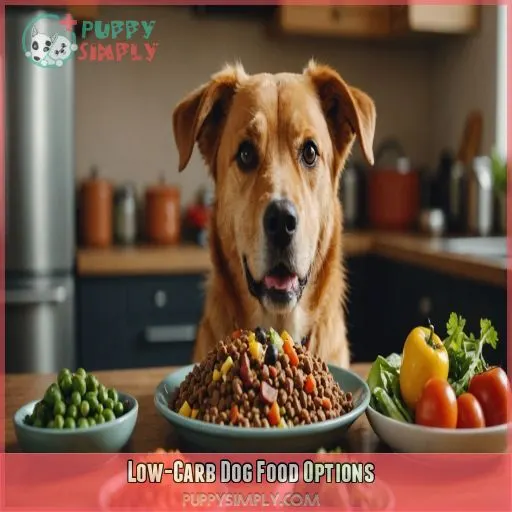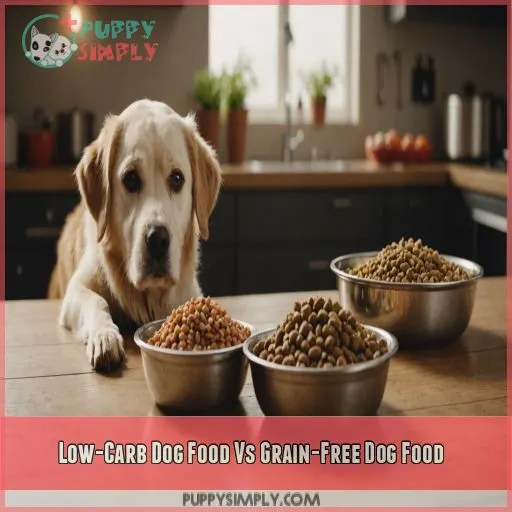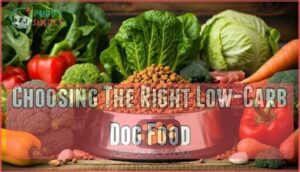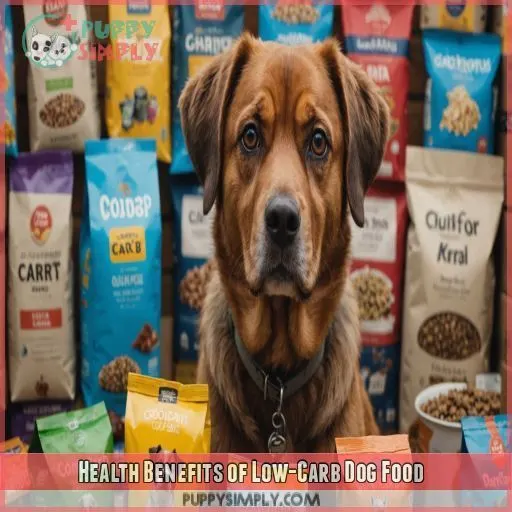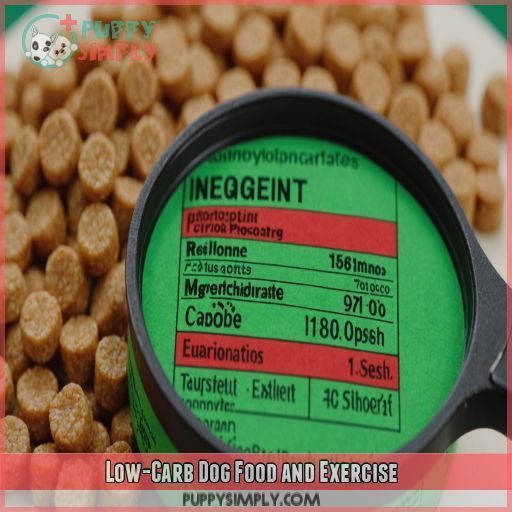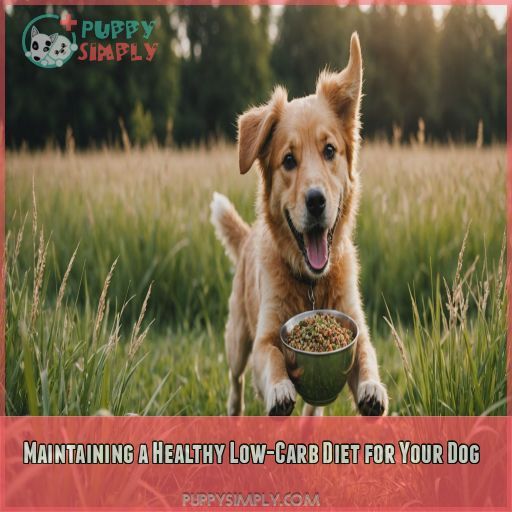This site is supported by our readers. We may earn a commission, at no cost to you, if you purchase through links.
 Looking for low-carb natural dog food options for your furry friend? You’re not alone! Many pet owners are ditching the grains and starches for a more primal approach to feeding their dogs.
Looking for low-carb natural dog food options for your furry friend? You’re not alone! Many pet owners are ditching the grains and starches for a more primal approach to feeding their dogs.
Low-carb dog food focuses on protein and fat, mimicking the diet of wild canines. By choosing a low-carb natural dog food, you can help your dog manage their weight, boost energy levels, and even reduce allergies.
But with so many options out there, where do you start? Let’s sniff out the best low-carb natural dog food options together – your pup’s tail will thank you!
Table Of Contents
- Key Takeaways
- Low-Carb Dog Food Options
- Low-Carb Dog Food Vs Grain-Free Dog Food
- Top 4 Low-Carb Natural Dog Food Options
- Choosing the Right Low-Carb Dog Food
- Health Benefits of Low-Carb Dog Food
- Low-Carb Dog Food for Specific Needs
- Low-Carb Dog Food Brands to Avoid
- How to Calculate Carbohydrate Content in Dog Food
- Low-Carb Dog Food and Exercise
- Maintaining a Healthy Low-Carb Diet for Your Dog
- Frequently Asked Questions (FAQs)
- What dog food has the least amount of carbohydrates?
- What is low carb food for dogs?
- Is blue buffalo dog food low carb?
- Is grain-free dog food low carb?
- Can puppies safely eat low-carb dog food options too?
- Is low-carb dog food more expensive than regular food?
- How do low-carb dog foods affect a dogs breath?
- Can low-carb dog foods help with dog allergies issues?
- Do low-carb dog foods cause more shedding in dogs?
- Conclusion
Key Takeaways
- You’ll want to choose low-carb dog food options that are high in protein and fat, and low in grains and starches. Think of it like putting your pup on a canine keto diet – it’s all about cutting down on those pesky carbs while ramping up the good stuff!
- Low-carb dog food can be a game-changer for your furry friend’s health, helping with weight management, boosting energy levels, and even reducing allergies. By ditching the grains and starches, you’re giving your pup a more primal approach to eating that’s closer to their natural diet.
- Don’t assume that all grain-free dog foods are low in carbs – some can be surprisingly high! Always check the nutrition label to ensure you’re getting a truly low-carb option that meets your pup’s needs.
- When making the switch to low-carb dog food, remember to transition slowly and keep an eye on your pup’s reaction. You may need to adjust their diet based on their individual needs, so be patient and work with your vet to find the perfect balance.
Low-Carb Dog Food Options
You’ve heard about low-carb diets for humans, but did you know they can benefit your furry friend too? Let’s explore low-carb dog food options and how they can help your pup stay healthy and energetic.
What is Low-Carb Dog Food?
Low-carb dog food is like putting your pup on a canine keto diet. It’s all about cutting down on those pesky carbs while ramping up the protein and fat. Here’s what you need to know:
- Lower in grains and starches
- Higher in meat and animal proteins
- Often includes healthy fats like fish oil
- May contain low-carb veggies for fiber
This diet mimics what your furry friend’s ancestors chowed down on in the wild. It’s not just a fad; many vets are barking up this tree for good reason!
Benefits of Low-Carb Dog Food for Dogs
Low-carb dog food can help your furry friend manage their weight.
It can also boost their energy levels.
Low-carb dog food is good for your dog’s digestive health and can reduce allergies.
It can even help manage diabetes by keeping blood sugar levels in check.
Common Sources of Protein in Low-Carb Dog Food
Now that you know the benefits, let’s talk protein sources in low-carb dog food.
You’ll find options packed with chicken, beef, fish, lamb, and turkey.
These meats aren’t just tasty; they’re powerhouses of essential nutrients.
Think of them as your pup’s personal fuel cells!
High-quality brands often use a mix of these proteins, ensuring your furry friend gets a well-rounded diet.
It’s like a doggy buffet, minus the carb overload!
Issues Caused by High-Carb Dog Food
High-carb dog food can be a real doggy downer. It’s like giving your pup a sugar rush followed by a crash. Here are three key issues to watch out for:
- Weight gain: Your furry friend might start looking more like a furry blimp.
- Diabetes risk: High blood sugar isn’t just for humans – dogs can get diabetes too.
- Energy rollercoaster: One minute they’re bouncing off the walls, the next they’re napping like it’s their job.
Low-Carb Dog Food Vs Grain-Free Dog Food
You’re probably seeing a lot of talk about low-carb and grain-free dog food these days, right? But are you clear on what makes them different? Let’s break down how these two types of dog food compare and whether grain-free automatically means low-carb. That way, you can make the best choice for your pup’s health and happiness.
Differences Between Low-Carb and Grain-Free Dog Food
You’ve probably heard about low-carb and grain-free diets for your furry friend. But what’s the real deal? Let’s break it down:
| Aspect | Low-Carb | Grain-Free |
|---|---|---|
| Focus | Reduces overall carbs | Eliminates grains |
| Ingredients | May include whole grains | Uses alternative carb sources |
| Health Benefits | Weight management, diabetes control | Potential allergy relief |
Is Grain-Free Dog Food Always Low-Carb?
You might think grain-free dog food is always low-carb, but that’s not always the case. Some grain-free options swap grains for high-carb alternatives like potatoes or peas. It’s really important to check the ingredients and carb content, not just the "grain-free" label. Here’s what to keep in mind:
- Woof! Don’t let fancy marketing fool you.
- Sniff out those sneaky carb sources.
- Bark up the right tree with proper research.
- Fetch the best nutrition for your furry friend.
- Roll over those misconceptions about grain-free diets.
Pros and Cons of Grain-Free Dog Food
Grain-free dog food has its pros and cons, just like your favorite pair of jeans. Let’s break it down:
| Aspect | Pros | Cons |
|---|---|---|
| Nutrition | Higher protein content | May lack essential nutrients |
| Allergies | Can reduce food sensitivities | Not all dogs need grain-free |
| Cost | Often uses premium ingredients | Generally more expensive |
| Digestibility | Easier for some dogs to digest | Can cause digestive issues in others |
| Carb content | Can be lower in carbs | Not always low-carb |
Top 4 Low-Carb Natural Dog Food Options
Are you looking for the best low-carb natural dog food options for your furry friend? Let’s explore four top choices that’ll keep your pup healthy and energized without packing on the pounds.
1. Diamond Naturals Beef Rice Adult Dog Food
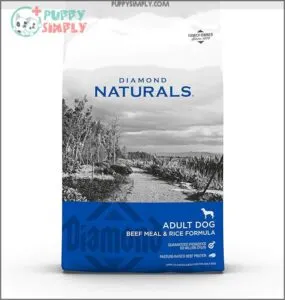
Looking for a low-carb option that won’t break the bank? Diamond Naturals Beef Rice Adult Dog Food might be your new best friend.
It’s packed with real beef, so your pup will be wagging their tail at mealtime.
Plus, it’s got a secret weapon: probiotics and superfoods to keep your dog’s tummy happy.
The larger kibble size is perfect for big dogs, but don’t worry if you’ve got a mixed-size pack – there’s a smaller version too.
While it’s grain-inclusive, it skips the corn, wheat, and soy, making it a solid choice for dogs with sensitive stomachs.
Best For: Dogs with sensitive stomachs, larger breeds, and pet parents looking for a budget-friendly, high-quality option.
- Real beef for a delicious and protein-packed meal.
- Probiotics and superfoods for healthy digestion.
- Grain-inclusive but free of corn, wheat, and soy.
- Availability can be inconsistent, especially online.
- Price can be higher for larger dogs.
- Shipping times may be unpredictable.
2. Pro Plan High Calorie Dog Food
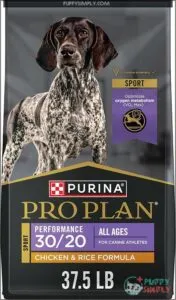
Pro Plan High Calorie Dog Food is a great choice for active dogs.
It’s packed with protein and fat to fuel your pup’s energy.
Here’s what makes it a winner:
- 30% protein and 20% fat – This powerhouse kibble gives your dog the energy they need to stay active.
- Real chicken as the first ingredient – This ensures your pup’s muscles stay strong and ready for action.
- Optimized oxygen metabolism – Your dog can keep chasing squirrels all day long.
-
Added EPA and glucosamine – It’s got your best friend’s joints covered too.
It’s like a gym membership in a bowl!
Best For: Active dogs who need a high-calorie, protein-packed diet to fuel their energy.
- High protein and fat content for maximum energy.
- Real chicken as the first ingredient for strong muscles.
- Contains EPA and glucosamine for joint health.
- Can be expensive.
- Some customers have reported issues with packaging and delivery.
- May not be suitable for dogs with dietary restrictions or sensitivities.
3. Blue Buffalo Wilderness Red Meat Dog Food
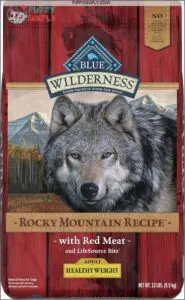
Looking for a protein-packed, low-carb option for your furry friend? Blue Buffalo Wilderness Red Meat might be your ticket. It’s like a steakhouse buffet for dogs!
This grain-free formula is loaded with beef, making it a muscle-building powerhouse.
Plus, it’s designed to help your pup maintain a healthy weight – no doggy diets needed!
The LifeSource Bits are like a multivitamin, supporting immune health with antioxidants.
While it might make your wallet a bit lighter, many pet parents swear it’s worth every penny. Your dog’s tail will be wagging in no time!
Best For: Active adult dogs looking for a high-protein, grain-free diet with added joint support.
- High-protein formula for muscle building and energy
- Grain-free recipe to help avoid common sensitivities
- LifeSource Bits provide essential antioxidants for immune health
- Pricey compared to some other brands
- Availability might be limited in some stores
- May not be suitable for all dogs, especially those with specific dietary needs
4. Grain Free White Fish Salmon Dog Food
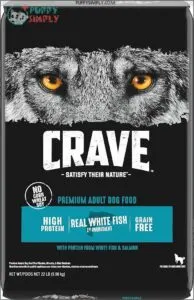
You’ve hit the jackpot with CRAVE Grain Free Adult Dry Dog Food. This salmon and ocean fish blend is a swimmer’s delight, packing a protein punch at 34%. It’s like a fish market in a bag – minus the smell! Well, almost. Some pup parents note it’s got quite the aroma.
While it’s grain-free, it’s not carb-free. Lentils and peas step in for energy. But don’t worry, there’s no artificial junk or chicken by-products here. It’s suitable for all dog sizes, though some big boys might find the kibble a bit small. Mixing it up could be your ticket to tail-wagging success!
Best For: This food is best for smaller dogs or owners who don’t mind mixing it with other brands for larger kibble size.
- High protein content (34%)
- Grain-free with no artificial ingredients
- Suitable for all dog sizes
- Strong fish smell
- Kibble size may be too small for large dogs
- Some customers mix it with other brands
Choosing the Right Low-Carb Dog Food
Choosing the right low-carb dog food can be a bit of a puzzle, but don’t worry – we’re here to help. In this section, we’ll break down the key factors to keep in mind when picking a low-carb diet for your furry friend and guide you through the process of switching them to their new meal plan.
Factors to Consider When Choosing Low-Carb Dog Food
When picking a low-carb dog food, consider your furry friend’s unique needs.
Factor in their age, breed, and any health issues.
Look for high-quality protein sources and natural ingredients.
Steer clear of grains, corn, and potatoes.
Don’t forget to check the cost per serving – your wallet matters too!
Transitioning Your Dog to a Low-Carb Diet
Once you’ve picked the right low-carb dog food, it’s time to switch them over.
Think of it like easing your pup into a new exercise routine – slow and steady wins the race.
Start by mixing a small amount of the new food with their current chow, gradually increasing the ratio over 7-10 days.
Keep an eye on your furry friend’s reaction and consult your vet if you notice any tummy troubles.
Health Benefits of Low-Carb Dog Food
You’ve made a smart choice by considering low-carb dog food for your furry friend. Let’s explore the impressive health benefits that come with this dietary approach, from weight management to improved digestion and even a reduced risk of diabetes.
Weight Loss and Management
Now that you’ve chosen the right low-carb dog food, let’s talk about shedding those extra pounds.
Your furry friend’s waistline will thank you!
Low-carb diets can be a game-changer for weight management.
By reducing carbs and increasing protein, you’re helping your pup feel fuller longer.
Pair this with a customized exercise routine and watch the transformation.
Improved Digestion and Reduced Allergies
Low-carb dog food can be a game-changer for your pup’s tummy troubles.
By cutting out the carb culprits, you’re giving their digestive system a break.
Think of it as a spa day for their gut!
With fewer irritants, your furry friend may experience less bloating, gas, and upset stomachs.
Plus, many low-carb options are packed with probiotics and high-quality ingredients, making them a treat for sensitive pooches.
It’s like giving their digestive system a VIP pass!
Increased Energy and Reduced Risk of Diabetes
You’ll notice a pep in your pup’s step with low-carb dog food. It’s like swapping out their doggy donuts for a power-packed breakfast! This diet can boost energy levels and help keep diabetes at bay. Here’s how:
- Stable blood sugar levels
- Improved insulin sensitivity
- Enhanced nutrient absorption
- Reduced inflammation
Low-Carb Dog Food for Specific Needs
Low-carb dog food isn’t just a one-size-fits-all solution; it can be customized to meet specific canine health needs. Whether your furry friend has diabetes, food allergies, or is entering their golden years, there’s a low-carb option that can help them thrive.
Low-Carb Dog Food for Diabetic Dogs
If your furry friend has diabetes, choosing the right low-carb dog food is really important. You’ll want to focus on high-protein, low-glycemic options that won’t spike their blood sugar. Here’s a quick comparison of some top diabetic dog food brands:
| Brand | Protein % | Carbs % | Cost/500 cal |
|---|---|---|---|
| Ketona | 46% | 5.3% | $1.47 |
| Hill’s Rx | 37% | 38% | $1.10 |
| Orijen | 38% | 28% | $1.31 |
| Visionary | 56% | 1% | $1.55 |
Low-Carb Dog Food for Dogs With Food Allergies
If your furry friend has food allergies, low-carb dog food can be a game-changer.
Look for allergy-friendly brands that offer hypoallergenic recipes with natural ingredients.
Skip the grains and potatoes, common culprits for allergic reactions.
Consult your vet for recommendations that fit your pup’s needs.
Low-Carb Dog Food for Senior Dogs
- Supports joint health, keeping them spry as a spring chicken
- Helps maintain a healthy weight, no more "chunky monkey" worries
- Boosts energy levels, so they’re not always "dog tired"
- Eases digestive issues, because nobody likes a gassy pooch
- Reduces food allergies, keeping itchy paws at bay
Low-Carb Dog Food Brands to Avoid
Choosing the right low-carb dog food is really important, but it’s also key to know which brands to avoid. In this section, we’ll explore some dog food brands that mightn’t be the best choice for your pup’s low-carb diet, whether due to high carb content, low-quality ingredients, or concerning recall histories.
Brands With High-Carb Content
We’ve talked about low-carb options, but it’s essential to know which brands to avoid.
Some popular kibbles are packed with carbs, even though they’re budget-friendly. Don’t be fooled by fancy marketing – many "healthy" brands are secretly loaded with carbs.
These high-carb foods can lead to weight gain and health problems for your furry friend.
Let’s figure out which brands to avoid and find better alternatives for your pup’s well-being.
Brands With Low-Quality Ingredients
When it comes to low-carb dog food, quality can vary wildly between brands.
Some manufacturers cut corners by using subpar ingredients.
Be wary of companies that aren’t transparent about their ingredient sources or use excessive fillers.
Artificial additives are also a red flag.
These shortcuts can lead to nutrient deficiencies and potential contamination issues.
Your furry friend deserves better!
Choose brands that prioritize natural ingredients and avoid artificial preservatives, fillers, and grains.
Brands With Recall History
When choosing low-carb dog food, it’s important to check out a brand’s recall history. Some brands have faced recalls due to safety issues, which can be a red flag. Here are key points to remember:
- Brand safety is paramount for your furry friend’s health
- Recall frequency can indicate ongoing quality control problems
- Recall impact may affect your dog’s well-being
- Transparency issues might suggest hidden ingredients
- Legal implications can arise from repeated recalls
Always research a brand’s track record before making it your pup’s daily feast!
How to Calculate Carbohydrate Content in Dog Food
Decoding dog food labels can feel like cracking a secret code, but don’t worry – we’ve got your back! In this section, we’ll show you how to become a pro at calculating carbohydrate content in your furry friend’s food, so you can make informed choices about their diet.
Understanding Dog Food Labels
Ever feel like you’re decoding a secret message when reading dog food labels? You’re not alone!
Let’s crack the code together. Start with the ingredient list – it’s your treasure map to what’s really in that kibble.
Look for high-quality protein sources like chicken or beef as the first ingredients. Keep an eye out for terms like "natural ingredients" and "no artificial preservatives" – they’re your best friends in the dog food aisle.
Calculating Carbohydrate Content
You might be wondering how to calculate the carb content in dog food. Well, it’s not as simple as just looking at the guaranteed analysis. Here’s the math:
- Carb Math: First, calculate the percentage of carbs by subtracting the percentage of protein, fat, moisture, and ash from 100.
- Fiber Focus: Then, check the fiber content. Fiber is a type of carb that can impact blood sugar and gut health.
- Sugar Sources: Also, look for sugar sources like corn syrup. These can spike blood sugar and are empty calories.
- Net Carbs: Finally, calculate net carbs by subtracting fiber from total carbs. This is a better indicator of the glycemic impact.
Tips for Choosing Low-Carb Dog Food
When choosing low-carb dog food, don’t get overwhelmed by the labels! Focus on carb content analysis, canine nutritional needs, and pricing. Consider low-carb brand options, and read pet owner testimonials. If your dog has grain allergies, look for potato-free, tapioca-free, and corn-free options. Make an informed decision, and your furry friend will thank you!
Low-Carb Dog Food and Exercise
You’re probably wondering how exercise fits into helping your furry friend thrive on a low-carb diet. Regular physical activity doesn’t just complement a low-carb diet, but also plays a key role in keeping your dog healthy and helping them maintain a good weight.
How Exercise Affects Low-Carb Diets
Now that you know how to calculate carb content in dog food, let’s explore how exercise affects low-carb diets. Regular physical activity impacts your dog’s carb needs, energy levels, and weight loss. Here are four key things to keep in mind:
-
- Increased energy needs: Exercise boosts your dog’s energy requirements.
-
- Weight loss: Regular physical activity supports weight loss.
-
- Muscle gain: Exercise helps build muscle mass.
-
- Balanced carb intake: Adjust carb intake based on exercise level.
Choosing the Right Exercise for Your Dog
Now that you know how exercise affects your dog’s low-carb diet, it’s time to choose the right physical activity for your furry friend.
Consider your dog’s age, breed, and fitness goals.
For example, high-energy breeds like Border Collies need intense workouts, while seniors may prefer gentle strolls.
Tailor the exercise to your dog’s unique needs to keep them happy and healthy.
Tips for Feeding Your Dog Before and After Exercise
Timing is key when it comes to exercise and low-carb dog food. You want to give your dog the fuel they need to perform at their best and recover properly. Here are some tips to get you started:
- Feed a balanced, low-carb meal with natural ingredients 1-2 hours before exercise to give your dog sustained energy.
- Provide plenty of fresh water before, during, and after exercise to prevent dehydration.
- After exercise, offer a post-workout snack with whole foods and no artificial flavors or colors to aid in recovery.
Maintaining a Healthy Low-Carb Diet for Your Dog
Now that you’ve made the switch to a low-carb diet for your dog, it’s important to keep an eye on their weight and overall health.
You can do this by regularly checking in and making adjustments as needed.
Tips for Maintaining a Healthy Weight
To keep your furry friend at a healthy weight, focus on portion control and balance exercise with treats. Make sure they drink plenty of water and eat whole, natural foods with no artificial flavors or colors. Limit table scraps and choose low-carb dog food with wholesome ingredients. Consistency is key, so stick to a routine and monitor progress.
Monitoring Your Dog’s Health
When monitoring your dog’s health on a low-carb diet, keep an eye on their weight, energy levels, coat condition, water intake, and stool consistency. Look for natural ingredients, whole foods, and avoid artificial flavors, colors, and by-products. Track changes and adjust as needed to make sure your furry friend stays happy, healthy, and thriving on their new diet.
Adjusting Your Dog’s Diet as Needed
As you monitor your dog’s health, you may need to adjust their diet. Don’t worry, it’s a normal part of finding the perfect balance. Here are some tips to keep in mind:
- If you notice food sensitivities, try switching to a different protein source or whole food ingredient.
- Gradually shift your dog to new foods to avoid digestive upset.
- Consult with your vet before making any significant dietary changes.
Frequently Asked Questions (FAQs)
What dog food has the least amount of carbohydrates?
You’re on the hunt for the lowest-carb dog food! According to the breakdown, Ketona takes the crown with only 3% of calories from carbs, costing $47 per 500-calorie serving – a great option for your furry friend!
What is low carb food for dogs?
Ever wondered what fuels your furry friend’s boundless energy? Low-carb dog food is a specially formulated diet that reduces carbohydrate content, focusing on protein-rich ingredients to support your dog’s overall health and well-being.
Is blue buffalo dog food low carb?
You’re wondering if Blue Buffalo dog food is low-carb? Unfortunately, it’s not the best option, with 41% of calories coming from carbs. If you’re looking for a low-carb diet for your pup, you may want to explore other options.
Is grain-free dog food low carb?
You’d think grain-free dog food is automatically low-carb, but think again! While some grain-free options are low in carbs, others can be surprisingly high, so always check the nutrition label to be sure.
Can puppies safely eat low-carb dog food options too?
You’re wondering if puppies can safely eat low-carb dog food options too? Generally, yes, but talk to your vet first, as puppies have different nutritional needs than adult dogs, and it’s important to make sure they get the necessary nutrients for growth and development.
Is low-carb dog food more expensive than regular food?
You’re wondering if low-carb dog food will break the bank! While some low-carb options can be pricier, others are comparable to regular food. On average, expect to pay between $50 to $47 per 500-calorie serving.
How do low-carb dog foods affect a dogs breath?
Did you know 80% of dogs over 3 years old have dental issues? Low-carb dog foods can actually help freshen your pup’s breath by reducing the amount of sugars and starches that contribute to tooth decay and bad breath.
Can low-carb dog foods help with dog allergies issues?
You’re wondering if low-carb dog foods can help with your pup’s allergy issues? The answer is maybe. Some low-carb dog foods are designed to be hypoallergenic, but you should talk to your vet to figure out the best approach.
Do low-carb dog foods cause more shedding in dogs?
You’re wondering if low-carb dog foods cause more shedding in dogs. The good news is, there’s no conclusive evidence to support this claim. You should keep an eye on your dog’s coat health during any dietary changes.
Conclusion
Now that you’ve sniffed out the best low-carb natural dog food options, it’s time to make the switch.
A primal approach to feeding your dog can be a game-changer.
By choosing low-carb natural dog food options, you’ll be helping your furry friend manage their weight, boost energy levels, and reduce allergies.
Make the change and watch your pup thrive – their tail will thank you!

